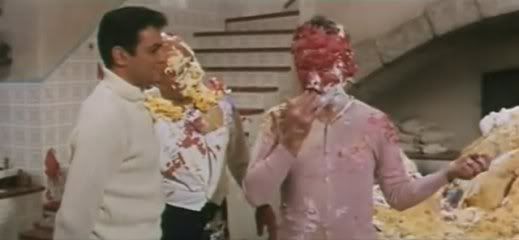When it comes to double-crossers, you are looking at the king!

Well, it appears I got Arthur Penn's much-belated tribute in just under the wire because today I learned that Blake Edwards died yesterday, also at the age of 88. As soon as I heard the news I knew exactly which film I would be watching in his honor: the one that saved my life 15 years ago. I spent the spring of 1995 studying abroad in England, a longtime dream made a reality that had an unfortunate side-effect. Namely, I was depressed a lot of the time and missed my friends and family terribly. This was exacerbated over Easter when all of my flatmates went home to their families, leaving me alone for the entire holiday weekend. Luckily, on Easter Sunday one of the television channels was airing a Blake Edwards film I hadn't seen before, so I sat down to watch it -- all two hours and 40 minutes of it. That's how I came to see The Great Race, a film that cheered me up immeasurably and made me feel like I still had something to live for. If nothing else, I had to live so I could see The Great Race again someday.
Made in 1965, when Edwards was flush with the double success of The Pink Panther and A Shot in the Dark, The Great Race was an epic undertaking and one that could have sunk his directing career if it hadn't been a success. And it was a smashing success -- with audiences, at least. (The critics didn't take too kindly to it at the time, but what do critics know? Sometimes it seems like they just want to be critical out of spite.) Edwards dedicated the film to "Mr. Laurel and Mr. Hardy," putting viewers on the alert for a slapstick-filled romp and he does not disappoint them. He does take his time getting to the titular race, though, thoroughly establishing the rivalry between dashing daredevil Tony Curtis (the hero in white) and the dastardly Jack Lemmon (the villain all in black with the Snidely Whiplash mustache to complete the package). He also throws a monkey wrench into the works in the form of suffragette reporter Natalie Wood, who enters the race to cover it and to provide Curtis with an eventual love interest. And also along for the ride are Peter Falk as Lemmon's bumbling henchman and Keenan Wynn as Curtis's able mechanic (who objects to Wood's presence mostly on chauvinistic grounds).
The sexual politics are mostly the result of Edwards's decision to set the film around the turn of the 20th century. (It doesn't get too specific beyond a reference to Teddy Roosevelt being president.) This places the action close to the birth of the automotive industry and, once the race from New York to Paris gets underway, allows Edwards to take a side trip to a wild west town (where a gigantic brawl breaks out, of course). And the extended running time (which includes an overture, intermission and playout music) even gives him the freedom to strand his characters in a lengthy subplot involving Lemmon's double, the buffoonish -- and constantly soused -- crown prince of Carpania. That may seem self-indulgent to some, but it culminates in the greatest pie fight in movie history, which makes the whole thing worthwhile. (It also represents the apex of indignities visited upon Lemmon's devious villain, who's previously been seen covered in feathers, mud and fire extinguisher foam.) There's a bit more film to go after the pie fight's over, but for my money everything after that scene is anticlimactic. Once a film has shot its wad in such a dramatic fashion, it's time to wrap things up.